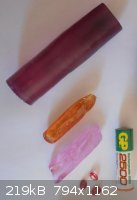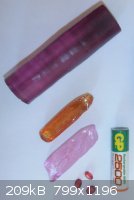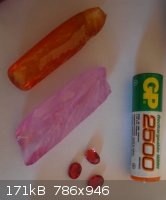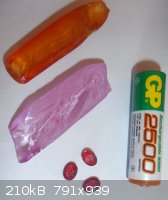| Pages:
1
2
3 |
rskennymore
Harmless

Posts: 12
Registered: 10-3-2014
Member Is Offline
Mood: Eutectic
|
|
So, after reading a bit about zirconium, I learned it forms a nitride so I opted for a 40 cubic foot tank of argon and pumped it into the furnace at a
rate of about 5 cubic feet per hour.
Evidently this isn't enough as after running the experiment I found a familiar crumbled heap of zirconium oxides. I have yet to sift through it for
ruby crystals but poking through the remains didn't turn up anything any bigger than what I saw with the first attempt using a zirconia crucible.
I'll post more information when it cools enough to sift through, but I'm starting to think this method of crystallizing alumina will require very
specialized materials.
|
|
|
deltaH
Dangerous source of unreferenced speculation
    
Posts: 1663
Registered: 30-9-2013
Location: South Africa
Member Is Offline
Mood: Heavily protonated
|
|
That's a pity... sorry to hear you got no joy from the zirconium!
|
|
|
rskennymore
Harmless

Posts: 12
Registered: 10-3-2014
Member Is Offline
Mood: Eutectic
|
|
So... The Zirconium went Chernobyl on me, though there are those tiny grains of ruby sand in there again.
Due to the relatively high cost of argon compared with nitrogen, I think I will focus on materials that are inert under nitrogen. I am wondering about
graphite now...
|
|
|
deltaH
Dangerous source of unreferenced speculation
    
Posts: 1663
Registered: 30-9-2013
Location: South Africa
Member Is Offline
Mood: Heavily protonated
|
|
I think the molybdenum trioxide is too strong an oxidant for graphite... it's almost certainly going to go chernobyl too (your fusing an oxidising
agent with an excellent fuel at 1000°C)!
I have discovered an interesting thing that has bearing on your experiments, aluminium molybdate, Al2(MoO4)3 is a known compound and has a low melting point (704°C) according to Wikipedia.
This is most likely the compound that forms when you fuse aluminium oxide and molybdenum trioxide by this reaction:
Al2O3(s) +3MoO3(l) <=> Al2(MoO4)3(l)
The implications of this is that it means you can actually dissolve a hell of a lot more alumina in molybdenum trioxide, because your actually forming
molten aluminium molybdate!!!
This means that you could/should maybe use a lot more alumina than what the authors used to form a 'saturated' solution, well not really a saturated
solution but actually just molten aluminium molybdate.
That said, perhaps then if forming aluminium molybdate, you could fire this in an alumina crucible, as now it's 'saturated' and so shouldn't dissolve
more alumina.
I think this might also help to form much larger crystals.
So my suggestion is this, use a mole ratio of MoO3 to gamma Al2O3 powders of 3 so that expressly target the formation
of aluminium molybdate and do this in a alpha alumina crucible.
Gamma alumina, being highly porous, should react/dissolve rapidly and preferentially with the molybdenum trioxide powder, whereas the alpha alumina
crucible should be much more kinetically inert because it is highly crystalline and has a low surface area for reaction.
[Edited on 18-5-2014 by deltaH]
|
|
|
PHILOU Zrealone
International Hazard
    
Posts: 2893
Registered: 20-5-2002
Location: Brussel
Member Is Offline
Mood: Bis-diazo-dinitro-hydroquinonic
|
|
The process seems fine, but I think the cistallization time and the size of the batch matters with regards to the size of the rubies obtained.
PH Z (PHILOU Zrealone)
"Physic is all what never works; Chemistry is all what stinks and explodes!"-"Life that deadly disease, sexually transmitted."(W.Allen)
|
|
|
Wizzard
Hazard to Others
  
Posts: 337
Registered: 22-3-2010
Member Is Offline
Mood: No Mood
|
|
Hypothetical process:
If we were to use a tall crucible, and fill the bottom with a strong mix of alumina and molyb trioxide
Add alumina with decreasing molyb trioxide to the top, to some end ratio by the filling point which is less than the ratio of MolybT:Alumina.
Then, heating strongly (>1000*C) from the bottom and keeping the (loosely capped) top of the crucible cooler than the base(<750*C)
I think as the molyb trioxide liquefies/reacts and slowly boils off, it works its way up and liquefies/reacts with the column of alumina, and larger
crystals may be formed as the denser solute falls and before all of the molyb trioxide is lost to the air, or works it's way out of the
mixture/solution.
I agree with deltaH - I think more alumina might help. But there's a chance, only a blob of alumina will be the end result.
|
|
|
PHILOU Zrealone
International Hazard
    
Posts: 2893
Registered: 20-5-2002
Location: Brussel
Member Is Offline
Mood: Bis-diazo-dinitro-hydroquinonic
|
|
Quote: Originally posted by PHILOU Zrealone  | | The process seems fine, but I think the cistallization time and the size of the batch matters with regards to the size of the rubies obtained.
|
I have long thought about it after seing a TV emission about 20 years ago where they have succeded in making big cristals of ruby; they where cristal
clear with faces and about 2cm long on 1,5 large... almost like homemade candies.
The process they used was a secret melting media very close to the natural one. The price of those artificial gems was 1/20 of the price of the
natural ones. Since the media was very close to the natural one, distinction between natural and artificial was very difficult, so to be fair, they
added dopping stuffs that allowed orange fluorescence under UV light or discrete radiations.
I have tried the melting process with acetylen-oxygen blowtorch (goes upt to 3100°C in the flame cone)...but with such gas processes one gets bubble
inclusions and carbon inclusions. I succeeded in doing tiny ruby spheres...but most of the Al2O3-Cr2O3 mix goes into the air while blowing.
To avoid this one could use a large Fresnel lens: this process is used to melt sand and allow to make 3D glass solar printer. With the sun beam, no
gas, only heat.
For the rest red corundum (ruby) can be used as laser pumper, or as special mirror because of its very high refractive index.
Corundum can be all colors by varying the trace amounts of colourizer oxyd.
No --> leuco corundum or colorless
Fe2O3 --> Yellow
Cr2O3 --> Red
CoO --> Blue (saphire)
CuO --> Green
FeO --> Blue
TiO2 --> Blue
By mixing one can get all colors from the rainbow and by lowering the quantity of colorizer one get very light shades.
The melting process like Verneuil's make cylinders that breaks irregularly into the lenght like glass. Those are used for training in jewelry.
I have some natural rubies and artificial ones... il will try to put a picture.
[Edited on 23-5-2014 by PHILOU Zrealone]
PH Z (PHILOU Zrealone)
"Physic is all what never works; Chemistry is all what stinks and explodes!"-"Life that deadly disease, sexually transmitted."(W.Allen)
|
|
|
deltaH
Dangerous source of unreferenced speculation
    
Posts: 1663
Registered: 30-9-2013
Location: South Africa
Member Is Offline
Mood: Heavily protonated
|
|
I would think that pink coloured gemstones would be sough after, even as synthetics. That would be a nice challenge for the hobby gemologist and one
could presumably sell pink stones on ebay for a modest premium over other synthetics.
The question is how to dope for pinks?
Some possibilities: Mn2+, Nd3+, Er3+??
If it was me, I'd try an erbium(III) oxide for a pretty fluorescent pink as the others may give varied results depending on the specifics of the
crystal habit.
[Edited on 24-5-2014 by deltaH]
|
|
|
rskennymore
Harmless

Posts: 12
Registered: 10-3-2014
Member Is Offline
Mood: Eutectic
|
|
As to adding more alumina, one of my attempts with a silicon carbide crucible I did try increasing the amount. I was left with basically blobs of
fused alumina. This might be a useful method of making fused alumina ceramics at lower temperatures, but it isn't very useful for making rubies.
My theory was there were too many nucleation sites for it to grow crystals of any visible size. Also these runs were done after I had cooked my first
thermocouple and was using the furnace's built-in thermocouple which isn't as accurate. It's possible the target temperature of 1100C was not reached
for long enough to ensure complete dissolution. I still think there was too much Alumina to dissolve though.
As to the formation of Aluminium Molybdate... If it does form it doesn't stick around at those temperatures. There is no mention of residue or
difference in mass of collected ruby crystals to that of the solute added in any of the publications I have found.
Wizzard's suggestion seems similar to the hydrothermal method, albiet a bit backwards. In the hydrothermal method, instead of Molybdenum Trioxide, an
aqueous solution of alkali hydroxides is used as the solvent at increased pressure and temperature. From what I have read, around 800 degrees in a
sealed steel "bomb". The seed crystals are placed at the top, which is kept cooler than the bottom, which is where the crystal "nutrients" are kept.
This is the method used to grow quarts for electronics purposes, and some of the NdYAG laser crystals and various other industrial crystals. Wizzard,
I suspect the cooler section would be where any crystals forming would grow, since the solubility of Alumina in the flux would be greatly diminished.
Doesn't mean it wouldn't work in reverse though...
PHILOU Zrealone: The characteristic blue color of sapphire comes from the mixture of Iron oxide and titanium oxide, and not from CuO. As I understand
it, it's the result of some complex physics having to do with the interaction of the two metal ions. I am not sure what color copper ions would
impart, but once I figure out the whole crucible problem I would love to find out 
deltaH: Couldn't you just limit the amount of chromium ions you add to get pink? Also looking at a few gemstone videos on youtube, I get the
impression the pink ones aren't exactly rare or sought after. Even the "natural" ones. Apparently they heat-treat them to oblivion so they aren't much
better than the Vernuli flame fusion rocks.
An update to the iridium crucible plan, I have obtained some Iridium sponge, and the chemicals needed to get it into solution. I haven't exactly got a
plan as to what to plate it onto yet, however. I have a small lump of Niobium and Nickel plating equipment, so that might be a cheap test.
I've been researching and I think my first choice for an actual crucible will be Molybdenum. Since it's been demonstrated that plating of Iridium
directly onto Molybdenum is possible without the need for the Nickel layer.
ww.mtialbany.com/wp-content/uploads/PDFs/A-72000-007-01-Molybdenum-Crucible-Price-List.pdf
45ml crucible for $415 USD...
At these prices though, not sure if it's worth it.
Molybdenum wire seems widely available on ebay, maybe I could plate onto that as a test and have a decent electrode for electrolysis for a perchlorate
cell later on.
I'll start a thread on Iridium plating in the techno chemistry section when I get around to undertaking that mess.
Think I need to get into grad school... My basement lab is ill equipped for this level of metallurgy.
[Edited on 24-5-2014 by rskennymore]
|
|
|
PHILOU Zrealone
International Hazard
    
Posts: 2893
Registered: 20-5-2002
Location: Brussel
Member Is Offline
Mood: Bis-diazo-dinitro-hydroquinonic
|
|
Quote: Originally posted by rskennymore  |
PHILOU Zrealone: The characteristic blue color of sapphire comes from the mixture of Iron oxide and titanium oxide, and not from CuO. As I understand
it, it's the result of some complex physics having to do with the interaction of the two metal ions. I am not sure what color copper ions would
impart, but once I figure out the whole crucible problem I would love to find out 
deltaH: Couldn't you just limit the amount of chromium ions you add to get pink? Also looking at a few gemstone videos on youtube, I get the
impression the pink ones aren't exactly rare or sought after. Even the "natural" ones. Apparently they heat-treat them to oblivion so they aren't much
better than the Vernuli flame fusion rocks.
[Edited on 24-5-2014 by rskennymore] |
If you read exactly what I wrote:
"Corundum can be all colors by varying the trace amounts of colourizer oxyd.
No --> leuco corundum or colorless
Fe2O3 --> Yellow
Cr2O3 --> Red
CoO --> Blue (saphire)
CuO --> Green
FeO --> Blue
TiO2 --> Blue
By mixing one can get all colors from the rainbow and by lowering the quantity of colorizer one get very light shades. "
You will see that Cobalt oxyde (CoO - what is also used as blue glass colorizer) alone but also Iron oxyde (II) and Titanium dioxyde (alone or in
mix) are responsible of the blue color of saphires and not Copper oxyde (CuO) what would make a green variant also obtainable by mixing TiO2 and/or
FeO and/or CoO (for the blue) and Fe2O3 (for yellow) ...
-->Blue + Yellow = Green!
Since we have Red-Yellow-Blue all colours are reachable.
Fire rubies (red with a slight orange shade) can be obtained with traces of Cr2O3 and even lower trace amount of Fe2O3
-->Red+Yellow = Orange
As mentionned lowering the trace amount will give light shades... Red diluted = Pink. 
Gemmology is one of my passions aside of chemistry...it is the expression of beauty of chemistry in the nature. I now have quite a big collection (I
collect precious and less precious gemstones for about 30 years now).
[Edited on 24-5-2014 by PHILOU Zrealone]
PH Z (PHILOU Zrealone)
"Physic is all what never works; Chemistry is all what stinks and explodes!"-"Life that deadly disease, sexually transmitted."(W.Allen)
|
|
|
Wizzard
Hazard to Others
  
Posts: 337
Registered: 22-3-2010
Member Is Offline
Mood: No Mood
|
|
When I get some time, I'll be giving my chemicals a mix and throwing them in the oven. Scary to think, my second favorite cup of crystals is *vastly*
dwarfed in value by the container, pictured here - Pt, courtesy of my good friend Ivan (whom I owe some serious time).

Full Size
[Edited on 5-25-2014 by Wizzard]
[Edited on 5-25-2014 by Wizzard]
|
|
|
rskennymore
Harmless

Posts: 12
Registered: 10-3-2014
Member Is Offline
Mood: Eutectic
|
|
Quote: Originally posted by PHILOU Zrealone  |
If you read exactly what I wrote:
"Corundum can be all colors by varying the trace amounts of colourizer oxyd.
No --> leuco corundum or colorless
Fe2O3 --> Yellow
Cr2O3 --> Red
CoO --> Blue (saphire)
CuO --> Green
FeO --> Blue
TiO2 --> Blue
By mixing one can get all colors from the rainbow and by lowering the quantity of colorizer one get very light shades. "
You will see that Cobalt oxyde (CoO - what is also used as blue glass colorizer) alone but also Iron oxyde (II) and Titanium dioxyde (alone or in
mix) are responsible of the blue color of saphires and not Copper oxyde (CuO) what would make a green variant also obtainable by mixing TiO2 and/or
FeO and/or CoO (for the blue) and Fe2O3 (for yellow) ...
-->Blue + Yellow = Green!
Since we have Red-Yellow-Blue all colours are reachable.
Fire rubies (red with a slight orange shade) can be obtained with traces of Cr2O3 and even lower trace amount of Fe2O3
-->Red+Yellow = Orange
As mentionned lowering the trace amount will give light shades... Red diluted = Pink. 
Gemmology is one of my passions aside of chemistry...it is the expression of beauty of chemistry in the nature. I now have quite a big collection (I
collect precious and less precious gemstones for about 30 years now).
[Edited on 24-5-2014 by PHILOU Zrealone] |
You did say Cobalt, I apologize. I was trippin, as they say.
|
|
|
PHILOU Zrealone
International Hazard
    
Posts: 2893
Registered: 20-5-2002
Location: Brussel
Member Is Offline
Mood: Bis-diazo-dinitro-hydroquinonic
|
|
Here are some artificial corundum I have aquired last year:
For reference of the size I have put a 1.5V AA Battery aside.
All where made via the Verneuil's process in the year 50-60.
-The big cylinder is about 3cm diameter and was normaly planned for optical/laser applications it is red-violet and costed like 60€.
-The orange and pink ones are half "bottles" or half "carots" costed each 3€.
-The tiny facetted rubies costed each 0,5€.
General overview in direct sunlight and under the flash of the camera:
 
Closer view in direct sunlight and under the flash of the camera:
 
[Edited on 25-5-2014 by PHILOU Zrealone]
PH Z (PHILOU Zrealone)
"Physic is all what never works; Chemistry is all what stinks and explodes!"-"Life that deadly disease, sexually transmitted."(W.Allen)
|
|
|
deltaH
Dangerous source of unreferenced speculation
    
Posts: 1663
Registered: 30-9-2013
Location: South Africa
Member Is Offline
Mood: Heavily protonated
|
|
Stunning PHILOU, very nice photos!
|
|
|
TheAlchemistPirate
Hazard to Others
  
Posts: 151
Registered: 25-3-2014
Location: The point of no return
Member Is Offline
Mood: Enigmatic
|
|
I am looking into making synthetic rubies too, but I don't know why we cant just use the Czochralski process with alumina and chromium oxide. I
figured I could build a firebrick electric furnace capable of reaching 2075 degrees Celsius, put it a graphite crucible and seal the space around the
top with firebrick and high-heat insulation foam. Then I would put a graphite rod in attached to a pulley slowly rotating it in the crucible, and let
the crystals collect on the rod. Wouldn't this work? I know this sounds dumb and obviously if it was this simple we would all be making rubies, but
please explain.
"Is this even science anymore?!"
|
|
|
Morgan
International Hazard
    
Posts: 1660
Registered: 28-12-2010
Member Is Offline
Mood: No Mood
|
|
iPhone 6 Sapphire Crystal Display!
https://www.youtube.com/watch?v=5R0_FJ4r73s#t=1m23s
|
|
|
| Pages:
1
2
3 |